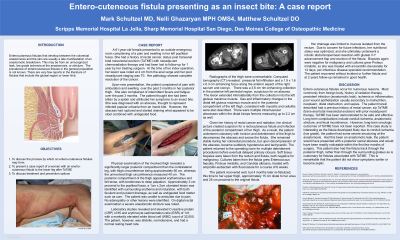General Surgery
Entero-cutaneous fistula presenting as an insect bite: A case report

Has Audio
Introduction/Purpose: Enterocutaneous fistulas that develop between the colorectal anastomosis and the skin are usually a late manifestation of an unrecognized anastomotic leak. The prevalence of enterocutaneous fistulas in the general population is not known. There are very few reports in the literature of fistulas that include the gluteal region or lower limb.
Methods or Case Description: 61 year old woman with a history of rectal cancer, status port TaTME treatment with subsequent radiation therapy. She was lost to follow-up and presented 1 year later at an outside hospital, complaining of what she thought was a bug bite along the posterior of her distal thigh. The "bite" formed an abscess which burst, yet stool and undigested food started draining from the wound. This created suspicion for a colocutaneous fistula.
Outcomes: At the time of I&D, her White Blood Count (WBC) was 32K. She became septic upon opening of the posterior compartment of the thigh despite her high WBC. She underwent end colostomy and multiple I&D of thigh to decompress the abscess and stop the fistula with eventual primary closure.
Conclusion: Colocutaneous fistulas occur almost exclusively as a complication of previous resection for diverticulitis, or from percutaneous drainage of diverticular abscesses. The patient herein described had a previous history of rectal cancer, s/p TaTME with subsequent radiation therapy. TaTME is associated with improved local control and better survival, as well as decreased postoperative genitourinary dysfunction due to pelvic autonomic nerve preservation. However, long-term oncologic outcomes of TaTME have not been reported. This case study shows the diversity with which an enterocutenous fistula may present and is an example of an atypical patient with different risk factors than would normally be expected.
Methods or Case Description: 61 year old woman with a history of rectal cancer, status port TaTME treatment with subsequent radiation therapy. She was lost to follow-up and presented 1 year later at an outside hospital, complaining of what she thought was a bug bite along the posterior of her distal thigh. The "bite" formed an abscess which burst, yet stool and undigested food started draining from the wound. This created suspicion for a colocutaneous fistula.
Outcomes: At the time of I&D, her White Blood Count (WBC) was 32K. She became septic upon opening of the posterior compartment of the thigh despite her high WBC. She underwent end colostomy and multiple I&D of thigh to decompress the abscess and stop the fistula with eventual primary closure.
Conclusion: Colocutaneous fistulas occur almost exclusively as a complication of previous resection for diverticulitis, or from percutaneous drainage of diverticular abscesses. The patient herein described had a previous history of rectal cancer, s/p TaTME with subsequent radiation therapy. TaTME is associated with improved local control and better survival, as well as decreased postoperative genitourinary dysfunction due to pelvic autonomic nerve preservation. However, long-term oncologic outcomes of TaTME have not been reported. This case study shows the diversity with which an enterocutenous fistula may present and is an example of an atypical patient with different risk factors than would normally be expected.

Matt M. Schultzel, DO
Surgeon
SHARP and Scripps Hospital systems
La Jolla, CA, US.jpg)
Nelli Ghazaryan, OMS-IV
Medical Student
Des Moines University
Tujunga, CA, US
